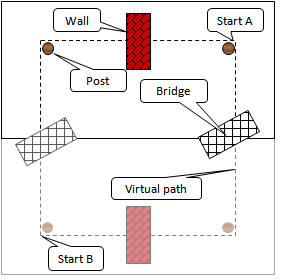 Obstacle
course
Obstacle
courseDesign and construct a self-contained vehicle capable of taking part in a race with a similar opponent, on an obstacle course described below.
 Obstacle
course
Obstacle
course
Four posts, placed at the corners of 1mx1m square, mark the racecourse. Contestants must race on a virtual (square) path encircling the four posts.
A wall (fixed to the platform) of proper height and width (*) is placed in the middle of each one of the two opposing edges. Contestants must go over these walls.
An overpass (bridge) of proper height and width (*) takes place at the middle of each one of the other two opposing edges. Vehicles must go under these bridges.
Height and width of the bridges should not exceed those of the walls.
The bridges are not necessarily aligned with the virtual path; robots should be capable of handling offsets up to ±45°.
Implementation
Teams are responsible to construct platforms that make up half of the racecourse, containing one wall (fixed to the platform), one bridge and two posts. The racecourse will be completed by bringing together the two halves.
Upon start command, teams will start their robots through means designed for the purpose.
Race rules
Contestants will start simultaneously, at the opposing corners of the virtual racecourse, in counter-clockwise direction, while properly going through the obstacles. The side that approaches and touches the opponent from the back wins the race.
(*) Common standards to be satisfied to make a fair competition possible, such as the size (width, thickness, height, etc.) and properties (color, material, etc.) of the posts, walls and bridges, height of the platform from the floor etc., are to be decided upon by a joint standards committee, composed of representatives of teams undertaking the project.